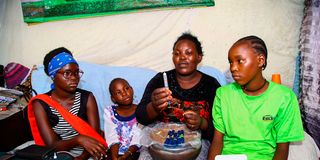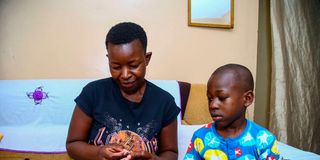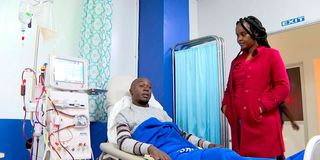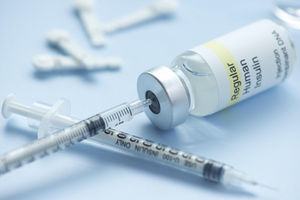High cost of diabetes care pushes poor patients to the brink

Veronicah Mwende (second right) with her diabetic daughters, (from left)Alekzinah Kambua, Priscah Shanaya and Blessing Mbithi, at their home in Kayole, Nairobi on January 20, 2024.
What you need to know:
- 537 million adults (20-79 years) are living with diabetes. (1 in 10 people).
- This number is predicted to rise to 643 million by 2030 and 783 million by 2045.
On a Monday mid-morning, we arrive at Veronicah Mwende’s residence in Matopeni, Kayole, an informal settlement nestled in the heart of Nairobi’s Eastlands.
An unmistakable sound of learners playing joyously in a neighbouring primary school rend the air as we stand outside her house. Despite it being a typical school day, her three school going children are at home.
Veronicah is a mother of seven and three of her children are diabetic.
Two days before Christmas Day in 2022, Veronicah, 37, observed a concerning change in one of her daughters –then eight years old. She woke up with sunken eyes and had for days complained of stomach upset, chest pains and exhibited an unusual intake of water and frequency in urination.
She was also wasting away.
“When I took her to a nearby health facility that afternoon, I thought her condition had deteriorated because of the chest pains. Little did I know that what awaited us was the unexpected revelation of a diabetes diagnosis, a condition I had always associated with old age,” says Veronicah.
When Veronicah received the diagnosis report, she told the doctor: “Surely, it can’t be diabetes. She is just a child.”
Veronicah was immediately referred to a referral facility and while there, her other 10-year-old daughter was also diagnosed with diabetes. “I had two children at the hospital and five at home. I am their sole parent and being at the hospital crippled my ability to provide for them. I had no one to look after them so I would stash part of our lunch at the health facility and share with them. Not so long after, my 15-year-old daughter, who is in secondary school, was also diagnosed with the same condition, type 1 diabetes,” she says.
The World Health Organization (WHO) notes that the number of diabetes cases has steadily gone up over the years. Beneath a stark statistic of more than 422 million people worldwide having the condition, it’s a profound transformation.
Once predominantly a “rich” people problem, diabetes has undergone a silent evolution, its prevalence rising faster in low-income countries and infiltrating households that are just scraping by.
Diabetes, WHO says, is a chronic disease caused by the pancreas not producing enough insulin or when the body cannot effectively use the insulin it produces. Insulin is a naturally occurring hormone made by the pancreas and its role is to assist the body in utilising sugar for energy.
“We have two common types of diabetes, that is Type 1 diabetes, where patients have little to no insulin in the body to help them metabolise glucose and therefore depend on insulin as a form of treatment as it’s irreversible. Our body cells require glucose to produce energy for all body functions. We also have Type 2 diabetes, where patients may have slightly reduced levels of insulin but have insulin resistance. It happens that they are not able to properly take up sugar, yet they may have adequate supplies of insulin.
“ The other one is gestational diabetes mellitus (GDM), which affects pregnant women and resolves after delivery,” says Dr Irene Njeri, a specialist in diabetes and endocrinology at the Nairobi West Hospital.
The diagnosis of her three children, Veronicah says, felt like an unexpected punch to her face. “I didn’t have a stable job that would earn me a regular income, so I was doing menial jobs to survive—whatever comes by, from laundry work to working at construction sites. When I left the hospital, I got a three months’ supply of insulin needles and the insulin vial. Beyond this initial period, I would need to explore alternative sources. Additionally, I was instructed to adjust the diet to make it a more balanced nutritional plan but that has been my greatest challenge. Misery is everywhere. My sporadic income from the menial jobs has reduced and this situation has taken a toll on my mental health. There are jobs I can no longer take up such as heavy lifting at the construction sites,” she says.
When the Healthy Nation team visits the family, the children are engrossed in a conversation; their physical appearance betraying any signs of illness.
“I couldn’t afford to provide a proper meal for them last night, which resulted in their blood sugars falling low. When that happens, I prefer they stay at home,” says Veronicah.
Eric Omondi, a project officer at the Kenya Diabetes Management & Information Centre, says when blood sugar levels in individuals with diabetes become low, a condition known as hypoglycaemia occurs.
“Hypoglycaemia, or low blood sugar, can happen when there is an imbalance between insulin (or other glucose-lowering medications) and the amount of glucose in the blood. This imbalance can be a result of various factors such as taking too much insulin, delaying, or skipping meals, or engaging in vigorous physical activity without adjusting insulin or food intake.”
Veronicah says she is totally dependent on well-wishers for her children’s treatment care, which costs at least Sh15,000 every month.
The general requirements for diabetic patients, Eric explains, include insulin, insulin syringes, glucometer strips and lancets. “Additionally, patients need a one-off purchase of glucometer, regular eye check and kidney function tests. Also, a quarterly HbA1c test, which is the average blood glucose (sugar) levels for the last two to three months,” he offers.
During the World Diabetes Day celebrations in Elgeyo Marakwet last November, Health CS Susan Nakhumicha acknowledged that 750,000 Kenyans are unable to access diabetes treatment due to the prohibitive costs and lack of access. A further 87 per cent of Kenyans, Ms Nakhumicha said, are not aware about their blood sugar status.
In Kawangware, a low-income residential area in Nairobi, Fibby Katsa is overcome with emotions as she recounts the profound impact her son’s diagnosis has had, completely upending her life.

Fibby Katsa draws blood from her diabetic son Lenox Nyongesa for blood sugar testing at their house in Kawangware, Nairobi on January 20,2024.
Her fourth born son, Lenox Nyongesa, was diagnosed with type 1 diabetes when he was barely four years old. He is now six.
“When my son started to exhibit symptoms such as extreme tiredness, dehydration and loss of weight, I made a mental note that I would take him for a medical check-up.
But the bills were pilling and every day was a struggle for survival, so I found myself repeatedly postponing the hospital visit, attempting to compensate by indulging him with his cravings,” she offers.
One afternoon, as they walked past a health centre, the little boy urged her to take him to the hospital.
“When I was told that he was diabetic, I wasn’t shocked because I didn’t know that it was a serious condition, which would upend our lives in all aspects, including an end to my marriage,” she offers.
The mother of five is unemployed and earns an average monthly income of Sh1 2,000 from menial jobs.
“Accessing his medications was my biggest headache after leaving the hospital because it was unavailable whenever I went to check, but thankfully, I got to know about the the Kenya Diabetes Management & Information Centre, that empowers people living with diabetes and they have been helping me get some of these supplies. However, I still buy the insulin syringes, which cost Sh300 every month. Many times I am forced to use the needle twice and stretch the one-month supply of insulin to three months,” she says.
Her biggest challenge, she says, is ensuring that she provides her child with a balanced diet. “With the high cost of living, it has become increasingly difficult to put not only a balanced diet but any meal on the table. Nowadays, I can only take up jobs that allow me to go to his school for his daytime injection and return home early so I can give him the insulin injections.
“On days when I can’t afford to feed my family, he forgoes the vital insulin injections – a perilous choice that I know it’s risky. Yet, faced with the harsh reality of the cost of living, what can I do?”
Without consistent and rigorous management of diabetes, research has shown that high blood sugar over a period can result in long-term complications such as blindness, heart and kidney disease, blood vessel deterioration, loss of limbs and a shortened life span.
Timothy Mwangi,39, grapples with the daily challenges of kidney failure, a harsh reality shaped by the long-term complications of diabetes.
For the past two years, Timothy, alias Tim and his wife of 14 years, Maureen Njuguna, has maintained one routine. Every Tuesday and Thursday, they leave their house in Kitengela at 4:30am and manouvre Nairobi’s perennial traffic to get to a health facility in Buruburu, Eastlands area by 6am. The facility accepts payment by NHIF, now SHIF. Otherwise, they would have to pay Sh9,500 for every clinic visit.

Timothy Mwangi undergoing a dialysis session as his wife Maureen Njuguna looks on.
“My dialysis sessions start at 9am but we have to factor in at least two hours of preparation. There is an afternoon session, but we opted for the morning one to afford time for other activities in the afternoon,” he shares.
Tim was diagnosed with Type 1 diabetes when he was about 19 years old. “I was in my third year in college and on that day, I was playing football when I felt a bitter taste on my tongue and I was also excessively thirsty. Familiar with the symptoms through a close diabetic relative, I had an intuitive certainty—I just knew I was diabetic,” he says.
A visit to the hospital confirmed that he had Type 1 diabetes and treatment started immediately.
“Unlike now where there are interventions from non-governmental organisations, the medication was not readily available, and it was also above my parent’s reach. I recollect that due to financial constraints, my parents couldn’t acquire a glucometer, so we were relying on clinic visits to ascertain my sugar levels. Whenever we went to the hospital, my sugar levels would be very high and at one point my knuckles had become very dark because of the high sugar levels. Since the diagnosis, a lot has changed — from my diet, nature of exercises and my career path,” he offers.
In 2021, a dietician informed him that both of his kidneys had failed, compelling him to embark on dialysis. The news came amidst the backdrop of managing high blood pressure and grappling with vision loss, a journey that led him through multiple surgeries.
“Unfortunately, I lost vision in my right eye and the remaining eye is partially blind. The irony is, I am a partially blind graphic designer and depend on my company to meet our needs. I also need assistance to get around, which necessitated my wife to get into entrepreneurship too; she’s a baker,” he offers.
At their home, virtually every meal is prepared in separate pots to cater to his specific dietary needs.
“Following the diagnosis of kidney failure, my meals became more restricted as I cannot eat food such as red meat, potatoes and tomatoes. Cooking separately has become a necessity to preserve the longevity of my meals and because we cannot afford to only eat white meat, which translates to an increase in other costs,” he offers.
Every month, the couple spends at least Sh40,000 on medical-related expenses. “At one point when I was almost totally blind, our family and friends shouldered most of our expenses. While their support continues, we now strive to sustain ourselves through work even though the challenge persists, given that nearly two full days each week are devoted to hospital visits,” he says.
The 39-year-old is currently pursuing a kidney transplant to replace his non-functioning kidneys.
“Despite the urgent necessity for a kidney transplant to restore my normal kidney function, reduce dietary restrictions and liberate me from the demands for frequent and time-consuming dialysis sessions, we cannot afford to pay for it and we are seeking support from well-wishers,” he says.





